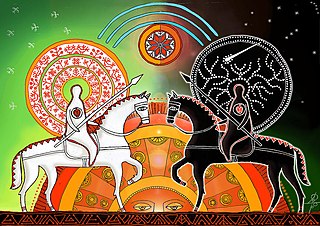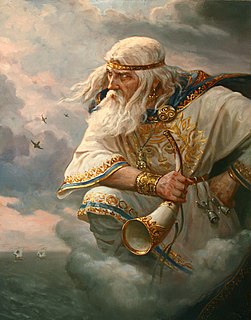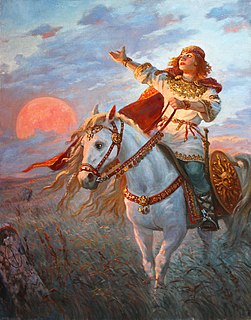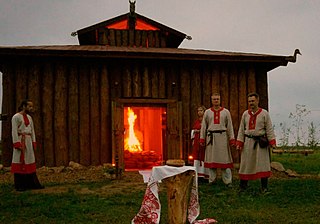
Belbog or Bielbog is the assumed name of the alleged god of auspicious fate worshiped by the Polabian Slavs. His name was derived by analogy to the Chernobog mentioned by Helmod in the Chronica Slavorum, who is a god of bad luck. The pair of these gods is often presented as evidence of "Slavic dualism," although their authenticity is controversial.

Lada and Lado are alleged Slavic deities. Lada was first mentioned around 1405-1412 in the sermons of Lucas of Wielki Koźmin, which warned against worshipping Lada and other gods during spring ceremonies and folk performances. They owe their popularity to Długosz, who in one of his sources recognized Lada as a goddess and in another as a god of war, the Polish equivalent of the Roman god Mars, to Aleksandr Faminstyn, who recognized the word Lada in Russian songs as the goddess of marriage, and to scholar Boris Rybakov, who insisted on recognizing her historicity. However, the vast majority of religious scholars and Slavists reject the historicity of these deities, believing that they owe their divine status to a misunderstanding of the song refrains by medieval scribes.

Stribog is a god in Slavic mythology found in three East Slavic sources, whose cult may also have existed in Poland. The sources do not inform about the functions of the god, but nowadays he is most often interpreted as a wind deity who distributes wealth.

Svarog is a Slavic god of fire and blacksmithing, sometimes, on the basis of a etymology rejected by modern scholarship, interpreted as a sky god. He is mentioned in only one source, the Primary Chronicle, which is problematic in interpretation. He is presented there as the Slavic equivalent of the Greek god Hephaestus. The meaning of his name is associated with fire. He is the father of Dazhbog and Svarozhits.

Rod, in the pre-Christian religion of Eastern and Southern Slavs, is the god of the family, ancestors and fate, perhaps as the supreme god. Among Southern Slavs, he is also known as Sud. He is usually mentioned together with Rozhanitsy deities. One's first haircut (postriziny) was dedicated to him, in a celebration in which he and the rozhanitsy were given a meal and the cut hair. His cult lost its importance through time, and in the ninth or tenth century he was replaced by Perun, Svarog and/or Svetevid, which explains his absence in the pantheon of Vladimir the Great.

Živa, Zhiva is a goddess of the Obodritic tribe of the Polabian Slavs. The goddess so appears only in the Chronicle of Helmold of Bozov. He described the strengthening of the pagan cult during the reign of Niklot:
In those days, the multifarious worship of idols and the error of superstition were fortified throughout Slavia. For apart from the sacred forests and the household deities, which abounded in the country and the cities, the most important and preeminent gods were Prone, god of Oldenburg country, Siwa, goddess of the Polabians, and Redigast, god of Obotrite country.

Khors is a Slavic god of uncertain functions mentioned since the 12th century. Generally interpreted as a sun god, sometimes as a moon god. The meaning of the theonym is also unknown: most often his name has been combined with the Iranian word for sun, such as the Persian xoršid, or the Ossetian xor, but modern linguists strongly criticize such an etymology, and other native etymologies are proposed instead.
Porenut is a god with unknown functions mentioned in only two sources: Gesta Danorum and in Knýtlinga saga. The only historical information about this god is the description of a statue depicting him with four faces on his head and a fifth face on his chest, which was held by his chin with his right hand and his forehead with his left hand.

Radegast, also Radagast, Radigost, Redigast, Riedegost, or Radogost, is an old god of Slavic mythology. He is considered to be a deity of hospitality, or host or leader of an assembly or council.
Podaga is a Polabian deity who had his statue in a temple in Plön. Mentioned only in Helmold's Chronicle, which does not give a depiction or function of the deity.
Among the Slavs there are many modes of idolatry and not all of them coincide with the same kind of superstition. Some create in their temples statues of fantastic forms, such as the idol of Plön, who is called Podaga, others live in forests and groves, as is the case of the god Prone of Oldenburg, of whom no image exists.

Yarovit is a god of war worshipped by Polabian Slavs associated with fertility and agriculture. In interpretatio romana, he was compared to Roman god of war Mars. His feast probably fell on April 15 or May 10 - sowing festival. His symbol was a golden shield that was kept in his temple. Because of the identical first part of the name he can be associated with the East Slavic god Yarilo, and because of the semantic similarity with Svetovit, some scholars suggest that both gods are related.
Rozhanitsy, narecnitsy, and sudzhenitsy are invisible spirits or deities of fate in the pre-Christian religion of the Slavs. Related to pregnancy, motherhood, marriage and female ancestors. Often quoted together with Rod. They are usually mentioned three together, but sometimes up to 9 together, of which one was a "queen" or singular. They are related to Dola, but it is not known on what terms. In Poland they were worshipped as zorze (auroras).

Niya is a Lechitic god of the underworld of unknown sex, whose exact functions are unknown. Niya is mentioned together with other gods worshipped by Poles, such as Yesha, Łada, or Devana. Niya's cult may be demonstrated by the sayings "Go to Niye" and "Dwell in Nya" collected by Polish ethnographer Aleksander Brückner. In recent years, the confidence in the authenticity of Niya has increased in the scientific community.
Jesza or Jasza is an alleged Polish god. He was first mentioned around 1405-1412 in the sermons of Lucas of Wielki Koźmin, which warned against worshipping Jesza and other gods during spring rituals and folk performances. He owes his popularity to Jan Długosz's comparison of him to the Roman god Jupiter. Contemporary researchers mostly reject the authenticity of the deity.

Svarozhits, Svarozhich is a Slavic god of fire, son of Svarog. One of the few Pan-Slavic gods. He is most likely identical with Radegast, less often identified with Dazhbog.
Porevit, Porovit or Borovit is a god with unknown functions mentioned in only two sources: Gesta Danorum and in Knýtlinga saga. The only historical information about this god is a description of a statue depicting him that had five faces and no weapons.
Dzidzilela, Dzidzileyla, Dzidzilelya is an alleged Polish goddess. First mentioned by Jan Długosz as the Polish equivalent of the Roman goddess Venus, goddess of marriage. Nowadays, the authenticity of the goddess is rejected by most researchers, and it is believed that the theonym was created by recognizing a fragment of folk songs as a proper name.
Pizamar is a Slavic deity worshipped on Rügen. His statue was overthrown by the Danes in 1168 together with statues of other gods on Rügen. He is mentioned only in Knýtlinga saga, which, however, does not give the functions of the god or his image. Nowadays his name may be transcribed into English as Pachomir, Pachemir.











